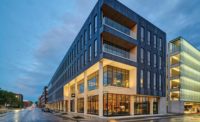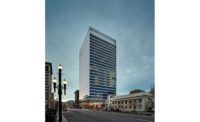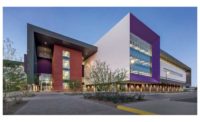111 East Grand
Des Moines, Iowa
Best Project
Owner: 111 E. Grand LLC
Lead Design Firm: Neumann Monson Architects
General Contractor: Ryan Cos. US Inc.
Structural Engineer: StructureCraft (Timber Superstructure); Raker Rhodes (Base Building)
Supply & Install Subcontractor: StructureCraft (Timber Superstructure)
Civil Engineer: Civil Engineering Consultants Inc.
M/E/P Engineer: Baker Group
Precast Concrete and Steel Supplier: PDM Precast Inc.
Located in the heart of Des Moines’ historic East Village, this 66,800-sq-ft, four-story mixed-use building is Iowa’s first modern mass timber structure, providing a sustainable design solution with the cost-saving and quality advantages of prefabricated materials and systems.
Given the building’s many unconventional aspects, early engagement with city building agencies helped identify and address potential code compliance and permitting issues.
Combining a precast core to provide lateral stability with a prefabricated mass timber gravity system helped speed construction.
It also challenged the project team to integrate the system’s differing construction tolerance expectations.
Wood construction’s natural aesthetics enable the structure to remain completely exposed as an interior finish, minimizing tenant improvement work and providing a natural interior working environment.
Spruce glulam beams and columns support prefabricated 7-ft by 40-ft dowel-laminated timber panels that serve as floor and roof decks. DLT, an all-wood, mass-timber panel, relies on a friction-fit bond between softwood dimensional lumber and hardwood dowels.
As all conduit and ductwork systems are exposed, the building systems design partner had to not only determine routing locations early but also provide a “finished” look.
Structurecraft managed the timber erection with a six-person crew of carpenters provided by Ryan Cos. The timber superstructure was erected in only six weeks.
Faced with limited supplies of the original exterior siding late in the project, the team identified black galvanized steel panels as a way to achieve a similar appearance. The move required a rapid skin redesign, procurement and installation process that was completed before the scheduled tenant move-in date.
Other issues included engineering floors for suitable vibration criteria, understanding the timber supply chain and lead time, planning for onsite weather protection and ensuring just-in-time delivery.
The one-year project was completed on schedule and on budget.





